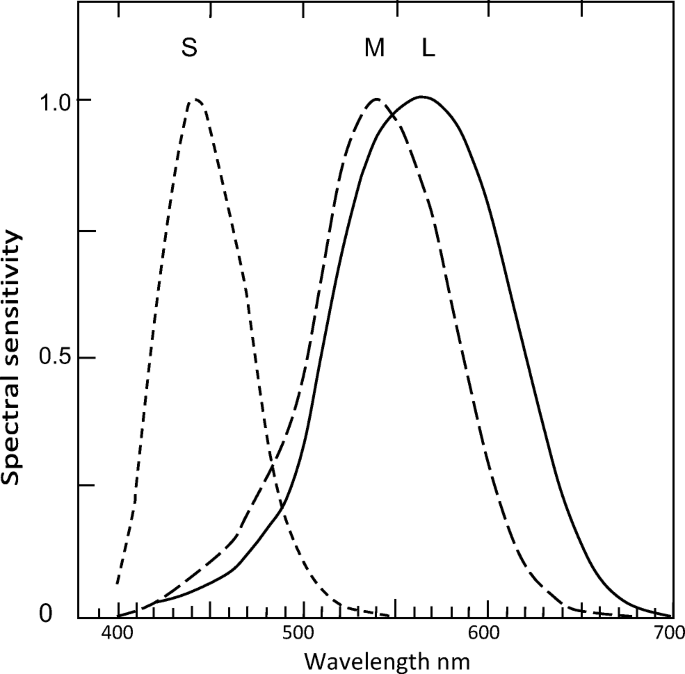linguistcat wrote: ↑Sun Apr 28, 2024 12:44 am
So from this, we could assume that having only one type of cone for normal daytime vision would be basically black and white vision but it would look different depending what the sensitivity peak and overall sensitivity curve for the single cone would be. Wavelengths outside the curve, no matter how bright, would look black; Colors closer to the peak would look brighter than ones far away.
I'm not sure you'd need both rods and cones. But since we have data on our cone system, let's use that.
We have three types of cones, S M L— for short, middle and long wavelengths. The spectral response curves look like this:

People often mislabel this graph with colors, e.g. painting the L curve red. This is wrong: the peak of the L curve is about 575 nm, which is a bright yellow. Only the frequencies above about 620 nm are "red." What we actually see are
combinations of these curves. If you plot L - M you get a beautiful sine wave that allows the brain to infer frequency: where it's low that's "green", where it's high that's "red". But that's not relevant for achromats.

The question is, which cone is best for general vision? S is crappy: it doesn't respond to all visible light. M is probably best as it's pretty much centered on the visible spectrum.
What does this mean for perception? One theory of our daytime achromatic perception— that is, our perception of brightness— is that it's L + M. That creates a curve right in between those two, peaking at about 515 nm. That is in fact why yellow looks close to white: it is stimulating both types of cone strongly.
But as you can see, L + M is not far from either curve. If our perception was based on M only, we might lose a few dark reds and maybe be slightly more sensitive to indigo.
I don't know if a single color at the peak of sensitivity at a given intensity would look the same as "white" light at the same intensity ("white" = light over the visible spectrum of these alt-humans), or if the "white" light would be slightly brighter.
It would look precisely the same. When we see a color, we are not seeing wavelengths directly. For that bit of visual space, the eye is basically merging all the frequencies and reporting the average. That means that there are an infinite number of ways to see, e.g., yellow:
* a single-frequency source at 575 nm
* a light of 650 nm (red) and 540 nm (green) - this is what your computer monitor does
* the broad spectrum of colors emitted by the sun, minus some high-energy photons scattered by the air; this is why the sun is yellow
* any number of other combinations
The eye/brain does not do frequency analysis, so it has no way of distinguishing these alternatives.
(The brain
does do frequency analysis on sound, which is why you can't arrange all sounds into a continuum.)
